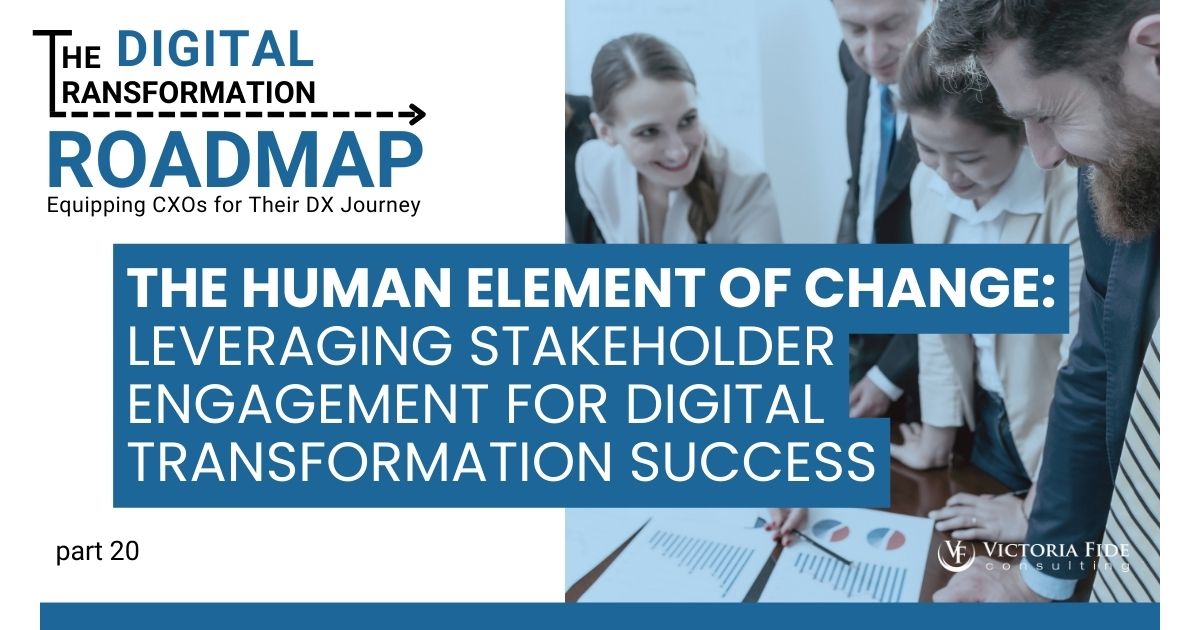
The Human Element of Change: Leveraging Stakeholder Engagement for Digital Transformation Success
The DX Roadmap series is produced by Victoria Fide Marketing with input and oversight from our leadership team and industry SMEs.
Table of Contents
In today’s rapidly evolving technological landscape, organizations are continually pushing towards digital transformation (DX) to help them stay competitive. However, despite the emphasis on technological advancements, one crucial factor often determines the success or failure of these initiatives: the human element.
Change management is a fundamental pillar of any transformational initiative. Where the benefits of the DX project may seem cut and dry to the project or executive sponsor, not everybody will view it the same way.
Resistance to change can stem from any number of underlying issues, so it’s important to devise a multi-faceted Change Management Strategy. Part of that strategy is to involve and actively engage stakeholders early on and at crucial milestones throughout the project.
In this article, we will examine the role of stakeholders within a digital transformation, how to conduct effective interviews to provide you with crucial insights into the team and project, and analyze those insights to enhance communication plans, training plans, resistance management, and more.
By engaging stakeholders in targeted, strategic ways, you can leverage the most impactful change agents within your organization, reducing risks and improving the results of your project.
Step One: Identify Key Stakeholders
First, it may be helpful to define a stakeholder. A stakeholder is any individual or group that has an interest, influence, or impact in the outcome of a project. Identifying and engaging specific stakeholders in your project is vital because they can either be champions or detractors. Their influence can sway the project in either direction, potentially making a good project bad, a bad project good, or a bad project even worse.
Gathering and analyzing as much information as possible early on during the Prepare phase is essential to equipping yourself and your team to manage these influences effectively and proactively remove any potential barriers that arise.
Key stakeholders can include the project sponsor, company leaders or managers, senior employees with a vested interest in the project, team members supplying resources to the project, and key change agents or advocates.
On the other hand, a stakeholder may be someone who opposes the project and has the influence to potentially block project progress. It is crucial to engage with all categories of stakeholders and gather as much information freely and willingly up front to effectively manage both positive change agents and potential blockers.
Step Two: Conduct Strategic Interviews
An Organizational Change Management (OCM) consultant would be the ideal role to conduct the stakeholder interviews. That consultant could be part of your internal team already but may be an external resource from a digital transformation consulting agency.
In some cases, this role may even be filled by the project manager (PM) or project sponsor. No matter the title of the team member, it is important that they possess the necessary skills and experience to conduct these interviews effectively while remaining objective.
The goal of these stakeholder interviews is to collect key stakeholders’ thoughts and feedback on the project, its potential outcomes, the people involved, as well as identify factors they perceive as crucial for success or failure. The setting for these interviews can vary—small group settings, one-on-one sessions, virtual discussions, or in-person meetings—depending on what facilitates the most candid feedback.
Group interviews can sometimes promote more collaborative discussion and feedback, whereas one-on-one sessions may provide a more comfortable atmosphere for sharing potentially difficult thoughts. No matter the setting, it’s important to keep the interview conversational and open-ended to avoid feeling like an interrogation.

Transformation is not easy, but it doesn’t have to be impossible. Take control of your project’s success today and schedule a free 30-minute consultation to find out how Victoria Fide can equip you for transformational success.
It’s best to approach these interviews with a prepared questionnaire customized to your project, team, and culture. Below is a list of topics to consider addressing during your interviews.
The Team:
- Number of members, roles, culture, communication styles
- Concerns about specific employees
- Identification of reliable change agents
History of Change:
- Stakeholder experience in navigating previous changes
- Challenges the team faced during past change initiatives
- Lessons learned from previous projects
The Project:
- Clarity and agreement on project objectives
- Perceived critical success factors
- Anticipated changes to processes
- Potential hurdles and challenges
Step Three: Analyze Results to Build Engagement Strategies
Once the interviews are complete, the next step is to analyze the results. The analysis should be conducted by someone experienced in engaging with diverse stakeholders to ensure a comprehensive understanding of the project’s complexities.
It may require input from multiple perspectives, including the Project Manager, the Project Sponsor, and other stakeholders who have a vested interest in the project’s outcomes. This collaborative approach helps to identify potential risks, opportunities, and areas for improvement.
The first step is to create a hierarchical list of all stakeholders and categorize them based on their level of influence and interest in the project. This can be done using a power-interest matrix and placing stakeholders in categories like high power/high interest, high power/low interest, low power/high interest, and low power/low interest. This matrix can help identify which stakeholders require more proactive engagement.
Next, be sure to document and organize all information gathered during the interviews, including the stakeholders’ level of influence, their attitudes toward the change, and their potential effectiveness as a stakeholder. Based on the information available, generate some strategies to best engage and utilize them throughout the process.
Utilizing Stakeholder Engagement to Drive Successful Change Management
Conducting these interviews and analyses is only beneficial if actionable steps are devised and implemented. The information from stakeholder interviews is instrumental in building the Change Management Plan, which forms the core of Organizational Change Management (OCM) activities in the Assess step of the Execute phase in our Process for Transformational Change. Here’s a list of the types of activities that the information from your stakeholder analysis will inform:
Stakeholder Engagement: Determines the most effective use of stakeholders and identifies suitable sponsors for the change.
Resistance Management: Identifies potential resistance points from teams or individuals, including the stakeholders themselves. Develops proactive strategies to address these concerns.
Communication: Informs the level and types of communication needed across all levels of the organization.
Training: Determines the necessary level of training for teams and specific individuals to ensure a successful transition to the new processes.
As the project progresses through the Execute phase and adjustments are made to the Change Management Plan and its activities, the information from the stakeholder analysis will remain crucial. It will inform the activities and level of involvement required as recommendations are made and the plan evolves.
Additionally, as more information from or regarding your stakeholders comes to light, it will serve to refine and enhance the areas and activities that are directly affected by that information.
Real-World Scenarios: Strategies for Increasing Stakeholder Engagement
Let’s take a look at some scenarios in which stakeholder interviews and analysis can change the course of a digital transformation initiative.
Scenario One: Stakeholder Favorable to the Change
Betty, an operations manager with long-standing tenure at the company, wields significant influence not only within her team but also among senior leadership, thanks to her dedication and loyalty. She oversees a diverse group, including manufacturing and warehouse management Business Process Owners (BPOs) and Subject Matter Experts (SMEs).
Betty is acutely aware of the challenges her team faces with the current processes and eagerly anticipates the day when they are relieved of some of their extra workload. She supports the project initiative that promises to bring long-term improvements for her team. However, she remains skeptical about the true impact it could have and worries that it might ultimately result in even more work for her team.
Analysis:
- Open to change
- Potential great stakeholder, but we must show Betty early on that despite short-term challenges, there will be long-term benefits.
- Holds strong influence and has direct communication with senior leadership.
Conclusion:
Maintaining close, regular communication with Betty is crucial for the success of the project. The PM should actively listen to feedback from her team members, ensuring that everyone’s voice is heard and considered. Additionally, leveraging Betty’s strengths and influence can help drive effective communication and boost morale within the team. By doing so, the PM can foster a more collaborative and productive working environment, where team members feel valued and motivated.
Scenario Two: Stakeholder Not Favorable to the Change
Alexander has been a controller at the company for several years, earning a reputation as a diligent worker and adept problem solver. His efforts have garnered high praise from company leaders, particularly for the positive changes he’s implemented within the Finance Team. Despite his successes, Alexander is resistant to transitioning to a new software system.
Although this system promises to streamline processes for other departments, his unfamiliarity with it leads him to believe it will complicate his workflow. His direct reports, who serve as Business Process Owners (BPOs) for the project, seem open to adopting the new system for the organization’s benefit. However, Alexander’s influence often overshadows their willingness to embrace the change.
Analysis:
- Is not favorable to the change and could drag down morale with his team
- Potential to be a good stakeholder and resource for his team, if we can harness his problem-solving ability
- Has potentially to be influential given past recognition he has received from company leaders
Conclusion:
In this scenario, Finance plays a central role in most business activities within the software systems. Given the critical roles filled by his BPOs, the PM should maintain close contact with Alexander. If Alexander can be convinced to support the change, he could significantly influence both his team and senior leaders, ensuring that the project is on the right track. Considering Alexander’s strong problem-solving abilities, the PM might want to brief him on upcoming challenges his BPOs will face. This proactive approach would allow Alexander to better support his team, addressing issues before they escalate.

Leveraging Stakeholder Influence for Change Management
Stakeholder interviews and thorough analyses form the bedrock of a successful Change Management Plan. By understanding the perspectives and concerns of key stakeholders who are both favorable and unfavorable to the change, organizations can tailor their strategies to enhance engagement, manage resistance, and ensure effective communication and training.
Moving forward throughout the project, it will be imperative to keep stakeholders informed, involved, and motivated, leveraging their influence and feedback to navigate the complexities of change. By doing so, organizations can pave the way for a seamless transition to new processes and systems, ultimately achieving their strategic objectives.
If you’re about to embark on a DX initiative and your team could benefit from well-informed and engaged stakeholders, reach out to Victoria Fide. Our experienced DX and OCM consultants are ready to empower your team to achieve the success they deserve.
Through careful analysis and intentional collaboration, we can help you navigate the complexities of change and achieve success in your digital transformation journey. We believe that by working together, we can make change positive and create a brighter future for your organization.
Subscribe to our weekly LinkedIn Digital Transformation Success newsletter and get notified of each new edition.
